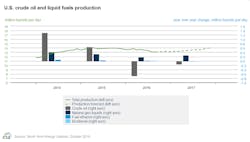EIA: US oil production, global oil inventory revised upward for 2017
In its October Short-Term Energy Outlook, the US Energy Information Administration forecasts US crude oil production to average 8.7 million b/d in 2016 and 8.6 million b/d in 2017. Forecast production in 2017 is almost 100,000 b/d higher than in the previous forecast, as a result of changes in modeling methodology applied to the Lower 48 states excluding federal Gulf of Mexico.
“Most important in the new methodology, all horizontal wells drilled since 2014 are fit with individual decline curves and projected out to 2020 before being aggregated to state and sub-state region levels. Aggregate decline curve parameters are also calculated for all other wells by states and intrastate regions,” EIA said.
Global oil inventory builds are forecast to average 700,000 b/d in 2016 and 300,000 b/d in 2017, which are 100,000 b/d lower and 300,000 b/d higher, respectively, than in the previous forecast.
“Estimated global inventory builds are lower in 2016 because of reductions in supply expectations based on historical data, particularly for the Organization of Petroleum Exporting Countries, China, and other Asia. In 2017, forecast inventory builds are higher, largely because of higher expected oil production in Russia and the US, along with lower expected global oil consumption,” EIA said.
Looser 2017 balances
In this month’s STEO report, EIA expects a looser 2017 global oil market compared with last month's projection. In the previous report, the market was expected to be relatively balanced in 2017.
“Increased oil production from Libya and Russia, along with the potential for reduced disruptions to Nigeria’s production, and a recovery in US crude oil production beginning in mid-2017 are contributing to expectations of looser 2017 balances in this STEO compared with last month,” EIA said.
In Libya, crude oil production averaged 310,000 b/d in September, and reached nearly 500,000 b/d at the end of the month, following the suspension of force majeures at a number of the ports that were previously blocked by militants aligned with the Petroleum Facilities Guard.
In Russia, recent oil production has been higher than previously forecast, with production exceeding previous records in recent months. In addition, the start-up of fields has resulted in a higher-than-expected outlook for Russian production. EIA now forecasts Russia’s oil production to increase 190,000 b/d in 2016 and 20,000 b/d in 2017. Previously, EIA had forecast declining Russian production in 2017.
Meanwhile, disrupted volumes of Nigerian crude are set to partially return in October, and some of the additional crude oil volumes could add supplies to the European market and put some downward pressure on Brent prices for delivery in the coming months.
The outlook for global crude oil demand in the October STEO has been revised modestly downward from the September STEO, with global oil demand expected to grow by 1.3 million b/d in both 2016 and 2017.
Oil-price forecast
Brent crude oil prices are forecast to average $43/bbl in 2016 and $51/bbl in 2017, $1/bbl higher and $1/bbl lower, respectively, than forecast in last month’s STEO. West Texas Intermediate crude prices are forecast to average about $1/bbl less than Brent in 2016 and in 2017.
Brent prices in this year’s fourth quarter and first-quarter 2017 are now forecast to average $48/bbl, $3/bbl higher than previously forecast. The higher forecast reflects lower expected global oil inventory builds during 2016 and lower risk of OPEC crude oil production coming in above forecast levels in 2017. Brent prices in the fourth quarter of 2017 are now expected to average $55/bbl, $3/bbl lower than previously forecast. The lower forecast reflects higher expected oil production in Russia and the US.
In this report, EIA also projects average US household expenditures for natural gas, heating oil, electricity, and propane will increase this winter (Oct. 1 through Mar. 31) compared with last winter. Based on projections from the National Oceanic and Atmospheric Administration, forecast temperatures this winter, measured using heating degree days, are 3% warmer than the previous 10-year average but colder than last winter, which was 15% warmer than the 10-year average nationally.


